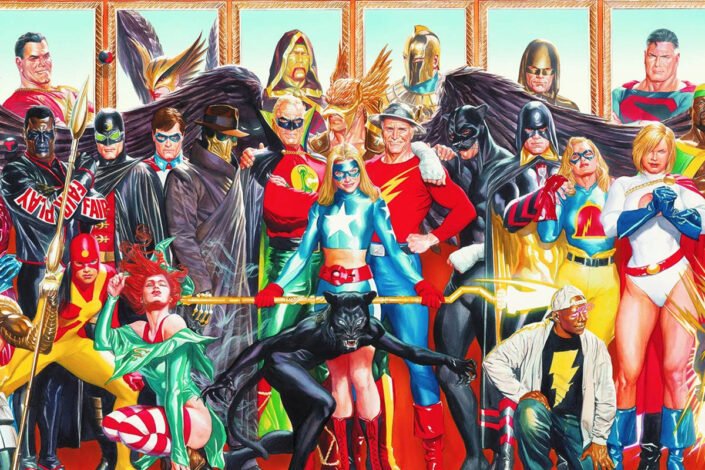
The Justice Society of America is the first team of superheroes in comic book history. Launched during the Golden Age of Comic Books, making its first appearance in All Star Comics #3 (Winter 1940-41), the JSA was conceived at DC Comics by editor Sheldon Mayer and writer Gardner Fox–Everett E. Hibbard was the artist on the title.
The original members of the Justice Society of America were Doctor Fate, Hourman, The Spectre, Sandman, Atom, Flash, Green Lantern (Alan Scott), and Hawkman. For a good decade, they were quite popular, but the team didn’t survive the post-war disinterest in superheroes in comics. Their adventures ceased with All Star Comics issue #57 (March 1951), but it was not the end for the JSA.
During the Silver Age, multiple members of the Justice Society of America were revamped and the team became the Justice League (see our JL reading order for more about that). At one point, the original JSA resurfaced, but this was on what became known as Earth-Two (the JL being on Earth-One). With a multiverse annual team-up with the Justice League, the JSA stayed alive and well for two decades–and even got a spin-off. Then, there was the 1985 Crisis on Infinite Earths that put an end to the JSA (and Earth-Two) for a time.
This didn’t last as a revival of the JSA happened in 1991. The old characters returned, but not in the past. But that didn’t last, a tragedy (an editorial one) occurred, the JSA disappeared, but was not forgotten.
In fact, the team was constantly present in the new Starman series by James Robinson (following his JSA: The Golden Age Elsewhere miniseries). This title led to another, a new JSA series. The team stayed active until the New 52 era, then disappeared again. The Rebirth era reestablished its place in the continuity though, but it was not until Geoff Johns came back to relaunch the title during the Infinite Frontier/Dawn of DC era that the Justice Society regained a bit of staying powers.
The Justice Society of America Reading Order
The most popular run of the Justice Society of America is the one written by Geoff Johns (post-James Robinson). This is where you probably want to start. In fact, like a lot of comics of the Golden Age era, the All Star Comics is dated, but it’s still readable if you have an affinity for the comics of that period (they can be fun).
- The JSA during the Golden Age
- The JSA during the Silver/Bronze Age
- The JSA during the Modern Age (post-crisis)
- The New Starman Era
- JSA by Geoff Johns (recommended starting point)
- JSA on Earth-Two during the New 52 Era
- The New Golden Age
![]()
The JSA during the Golden Age
Gardner Fox wrote the adventures of the JSA, John Broome and Robert Kanigher did too. For the art, some stories were illustrated by legendary artists like Joe Kubert, Jack Kirby, Joe Simon, Alex Toth, Carmine Infantino, Everett E. Hibbard, and a lot more.
All Star Comics #3 being the issue introducing the JSA, it was reprinted on multiple occasions. Other issues can be found in the 75th anniversary book:
- Justice Society of America: A Celebration of 75 Years
Collects All-Star Comics #4, 37, 55; Justice League of America #21-22, 30, 47, 82-83, #193; Adventure Comics #466; All-Star Squadron #67; Justice Society of America (Vol. 2) #10; JSA Returns: All-Star Comics #2; JSA #25; Justice Society of America (Vol. 3) #10; Earth 2 #6.
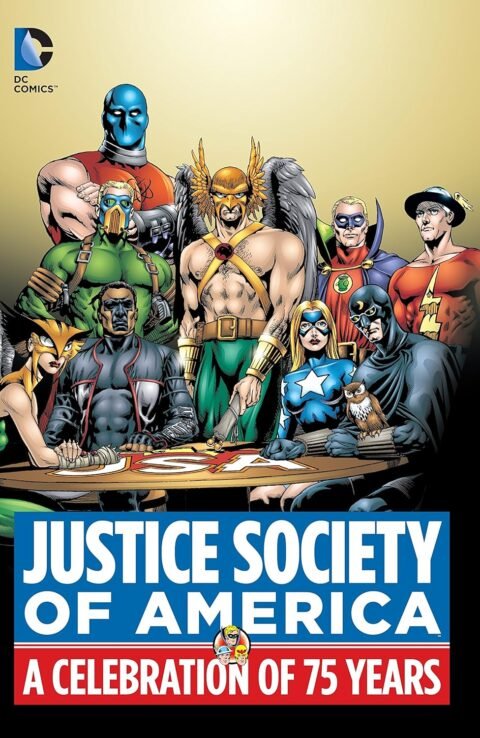
For a complete run, you need to track down the All Star Comics Archives:
- All Star Comics Archives Vol. 1
Collects All Star Comics #3-6. - All Star Comics Archives Vol. 2
Collects All Star Comics #7-10. - All Star Comics Archives Vol. 3
Collects All Star Comics #11-14. - All Star Comics Archives Vol. 4
Collects All Star Comics #15-18. - All Star Comics Archives Vol. 5
Collects All Star Comics #19-23. - All Star Comics Archives Vol. 6
Collects All Star Comics #24-28. - All Star Comics Archives Vol. 7
Collects All Star Comics #29-33. - All Star Comics Archives Vol. 8
Collects All Star Comics #34-38. - All Star Comics Archives Vol. 9
Collects All Star Comics #39-43. - All Star Comics Archives Vol. 10
Collects All Star Comics #44-49. - All Star Comics Archives Vol. 11
Collects All Star Comics #50-57.
![]()
The JSA during the Silver/Bronze Age
The original “Crisis” took place in JLA #21. The story introduced the idea of two different realities in order to explain how the heroes of the Justice League teamed up with their predecessors the Justice Society of America. This led to multiple crossovers between Earth-One and Earth-Two.
These next books are collecting the famous Multiple Earths team-ups from the Silver/Bronze Age era:
- Crisis on Multiple Earths Volume 1
Collects Justice League of America #21–22, 29–30, 37–38, 46–47. - Crisis on Multiple Earths Volume 2
Collects Justice League of America #55–56, 64–65, 73–74, 82–83. - Crisis on Multiple Earths Volume 3
Collects Justice League of America #91–92, 100–102, 107–108, 113. - Crisis on Multiple Earths Volume 4
Collects Justice League of America #123–124, 135–137, 147–148. - Crisis on Multiple Earths Volume 5
Collects Justice League of America #159–160, 171–172, 183–185. - Crisis on Multiple Earths Volume 6
Collects Justice League of America #195–197, 207–209, All-Star Squadron #14–15.
DC recently republished those stories in a new collection:
- Crisis on Multiple Earths Book One: Crossing Over
Collects Justice League of America #21-22, #29-30, #37-38, #46-47, #55-56, #64-65, #73-74, #76, and #82-83. - Crisis on Multiple Earths Book 2: Crisis Crossed
Collects Justice League of America #91-92, #100-102, #107-108, #113-124, #135-137, #147-148, and #159-160 - Crisis on Multiple Earths Book 3: Countdown to Crisis
Collects Justice League of America #171-172, #183-185, #195-197, #207-209, #219-220, #231-232; All-Star Squadron #14-15; and DC Comics Presents Annual #1.
![]()
The JSA during the Bronze Age
The JSA popularity grew to a level high enough for DC Comics to relaunch All-Star Comics. With All Star Comics #58 (January/February 1976), the original members came back as mentors for a new “Super Squad,” as they were now heroes in their 50s–it was the introduction of Power Girl but also of The Huntress (Helena Wayne)! The series ended with #74, but kept going anyway in the pages of Adventure Comics #461 to 466. Also, DC Special #29 delivered an origin story. This series was written by Gerry Conway and Paul Levitz, and artists included Ric Estrada, Wally Wood, Keith Giffen, Joe Staton, and Bob Layton.
- All-Star Comics Only Legends Live Forever
Collects All-Star Comics #58-74, Adventure Comics #461-466, and DC Special #29. Previously available in Justice Society Volume 1 and Justice Society Volume 2
During that period, the team crosses over with the JLA:
- Justice League of America #147-148 after All Star Comics #68
- Justice League of America #159-160 after All-Star Comics #74
- Justice League of America #171-172 after Adventure Comics #465
- the other JLA/JSA crossovers take place after Adventure Comics #466

![]() As the heroes of the JSA grew old, their adventures took place in the “present” (meaning the 1970s). It was not the case with the All-Star Squadron, a series created by Roy Thomas, with artists Rich Buckler and Jerry Ordway, taking place in the JSA’s original setting of the wartime 1940s. It basically retconned this new team in the history of DC superheroes. Being set during the Golden Age, members of the JSA made appearances.
As the heroes of the JSA grew old, their adventures took place in the “present” (meaning the 1970s). It was not the case with the All-Star Squadron, a series created by Roy Thomas, with artists Rich Buckler and Jerry Ordway, taking place in the JSA’s original setting of the wartime 1940s. It basically retconned this new team in the history of DC superheroes. Being set during the Golden Age, members of the JSA made appearances.
- Showcase Presents: All-Star Squadron Vol. 1
Collects Justice League of America #193; All-Star Squadron #1–18; and All-Star Squadron Annual #1. - All of the issues of All-Star Squadron can be found here.
![]() Created by Roy Thomas, Jerry Ordway, and Mike Machlan, Infinity, Inc. is a book (launched in 1984) following a team mostly composed of the children and heirs of the Justice Society of America. It’s a spin-off of All-Star Squadron introduced in All-Star Squadron #25. The series is not fully collected yet, but you can find all the issues here.
Created by Roy Thomas, Jerry Ordway, and Mike Machlan, Infinity, Inc. is a book (launched in 1984) following a team mostly composed of the children and heirs of the Justice Society of America. It’s a spin-off of All-Star Squadron introduced in All-Star Squadron #25. The series is not fully collected yet, but you can find all the issues here.
- Infinity, Inc.: The Generations Saga Vol. 1
Collects Infinity, Inc. #1-4, All-Star Squadron #25–26, and Annual #2. - America Vs. The Justice Society
Collects America Vs. The Justice Society #1-4.
![]()
In 1985, Crisis on Infinite Earths was the first universe-redefining crossover comic book event ever. The goal was to simplify and unify the DC Universe. The Earth-One/Earth-Two dichotomy was resolved by merging the Multiverse into a single universe. As a consequence, the Golden Age Superman, Batman, Robin, and Wonder Woman ceased to exist… A lot was erased from the continuity. For more information, go to our Crisis on Infinite Earths Reading Order.
- Crisis On Infinite Earths 30th Anniversary Deluxe Edition
Collects Crisis on Infinite Earths #1-12. - Crisis on Infinite Earths Companion Deluxe Edition Vol. 1
Collects DC Comics Presents #78, All-Star Squadron #50-60, The Fury of Firestorm #41-42, and Green Lantern #194-198. - Crisis on Infinite Earths Companion Deluxe Edition Vol. 2
Collects DC Comics Presents #86, Swamp Thing #44, Losers Special #1, Legends of the DC Universe: Crisis on Infinite Earths #1, Infinity, Inc. #18-25, Infinity, Inc. Annual #1, Justice League of America #244-245, New Teen Titans (Series 2) #13-14 and a story from Detective Comics #558.
In an effort to fix some continuity problems born from the Crisis on Infinite Earths, DC Comics decided to write off the JSA from active continuity. Roy Thomas wrote the one-shot “The Last Days of the Justice Society of America” to do just that. Only Power Girl, the Star-Spangled Kid, the Spectre, and Doctor Fate escaped the cataclysm. Also, Roy Thomas later revised the JSA’s origin to fit in the post-Crisis continuity in Secret Origins vol. 2 #31.
![]()
The JSA during the Modern Age (post-crisis)
First, to clear the slate after Crisis on Infinite Earths and re-launch the franchise, All Star Squadron was canceled with issue #67 and replaced with a successor series, Young All-Stars. Created and written by Roy Thomas, this series featured Neptune Perkins and young Dan the Dyna-Mite, but also introduced new heroes. You can find all the issues here.
In 1991, the JSA briefly came back with an eight-issue limited series set in the past with the classic “untold stories of the Golden Age” approach.
- Justice Society of America: The Demise of Justice
Collects Justice Society of America #1-8, Adventure Comics #466, and All Star Comics #57.
Then, during the four-issue Armageddon: Inferno limited series (unavailable–at the moment–sequel to the Armageddon 2001 event), the JSA returns to the modern-day DC Universe. This led to JSA vol. 2, a quickly canceled series set in the present day. Only 10 issues were published, they are not collected yet.
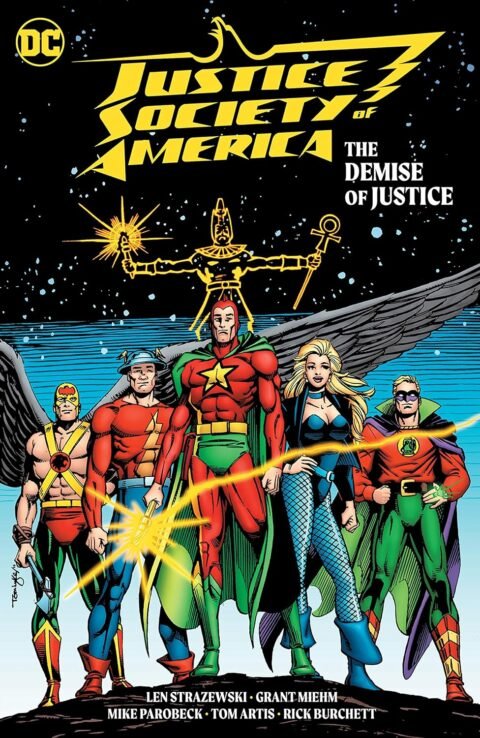
![]() And then came the Zero Hour: A Crisis in Time event (see reading order here). All of reality comes under attack when a mysterious force of entropy begins slowly erasing time itself—making its way from both the past and future toward the present! During the event, the JSA disbanded again as several members were slain or realized they were too old to continue. After that, only three members were still here: Jay Garrick still appeared in The Flash series, Alan Scott was rejuvenated and became known as Sentinel, and Starman passed his cosmic torch to his son.
And then came the Zero Hour: A Crisis in Time event (see reading order here). All of reality comes under attack when a mysterious force of entropy begins slowly erasing time itself—making its way from both the past and future toward the present! During the event, the JSA disbanded again as several members were slain or realized they were too old to continue. After that, only three members were still here: Jay Garrick still appeared in The Flash series, Alan Scott was rejuvenated and became known as Sentinel, and Starman passed his cosmic torch to his son.
- Zero Hour: Crisis in Time 25th Anniversary Omnibus
Collects Action Comics #703, Adventures of Superman #516, Anima #7, Batman #511, Batman: Shadow of the Bat #31, Catwoman #14, Damage #6, Darkstars #24, Detective Comics #678, The Flash #0 and #94, Green Arrow #90, Green Lantern #0 and #55, Guy Gardner: Warrior #24, Hawkman #13, Justice League America #92, Justice League International #68, Justice League Task Force #16, L.E.G.I.O.N. ’94 #70, Legionnaires #18, Legion of Super-Heroes #61, Outsiders #11, Robin #10, Steel #8, Superboy #8, Superman #93, Superman: Man of Steel #37, Team Titans #24, Valor #23, Zero Hour #4-0, and stories from Showcase ’94 #8-10, along with a foreword by Dan Jurgens, afterword by series editor KC Carlson, the Zero Month Sampler, and an extensive gallery of promotional and behind-the-scenes material.
![]()
The New Starman
Before writing the ongoing Starman series, James Robinson collaborated with Paul Smith on The Golden Age miniseries in which they revisited the Golden Age Justice Society. It’s part of the Elseworlds collection, but Robinson still used elements of that story in his work.
- JSA: The Golden Age
Collects The Golden Age #1–4.
Of course, Starman is not a “JSA” series per se, but it is full of old JSA members, a few stories are in fact JSA stories. Also, it led to the new Volume of JSA, but also to Stargirl.
What follows is the Compendium edition, the easiest way to acquire the Starman series today. Go to our Starman Reading Order to know when to start the new JSA.
- Starman Compendium One
Collects Starman (vol. 2) #0–42, Annual #1; The Shade #1-4; Starman Secret Files and Origins #1; Showcase ’95 #12, Showcase ’96 #4, Showcase ’96 #5,The Power of Shazam! #35-36 - Starman Compendium Two
Collects All-Star Comics 80-Page Giant #1, Batman/Hellboy/Starman #1-2, JSA All-Stars #4, Starman #43-81, Starman #1 (1998), Starman/Congorilla #1, Stars and S.T.R.I.P.E. #0, and The Shade #1-12.
Geoff Johns JSA Reading Order
This is probably the most famous iteration of the JSA at that point. The series was launched by James Robinson and David S. Goyer, but Geoff Johns (who also wrote the Stargirl series Stars and S.T.R.I.P.E.) quickly took over–with Goyer for a time, then alone–with art by Stephen Sadowski, Leonard Kirk, Don Kramer, and more. With Johns at the helm, the JSA became a popular series.
In this new volume of the JSA, three generations of crime fighters join together for the greater good: Sentinel, Wildcat, the Flash, Black Canary, Starman, Sand, Hourman, Atom Smasher, the Star-Spangled Kid, and Hawkgirl. The heroes of the present and legends of the past come together to form the Justice Society of America!
JSA by Geoff Johns Omnibus Edition
First, before going into details, here are the omnibus collection of the JSA series written by Geoff Johns. It is known that the issues collected in those books are not necessarily in good reading order, see this explanation for more details.
- JSA Omnibus Vol. 1
Collects JSA #1-25, JLA/JSA: Virtue and Vice, JSA All-Stars #1-8, JSA Our Worlds at War #1, JLA/JSA Secret Files #1, JSA Secret Files #1, All-Star Comics #1-2, All-American Comics #1, Adventure Comics #1, National Comics #1, Sensation Comics #1, Smash Comics #1, Star Spangled Comics #1 and Thrilling Comics #1. - JSA Omnibus Vol. 2
Collects JSA #26-81. - JSA Omnibus Vol. 3
Collects JSA #76-87, Justice Society of America #1-28, Justice League of America #8-10, Justice Society of America Annual #1, JSA Kingdom Come Special: Superman #1, JSA Kingdom Come Special: Magog #1, JSA Kingdom Come Special: The Kingdom #1.
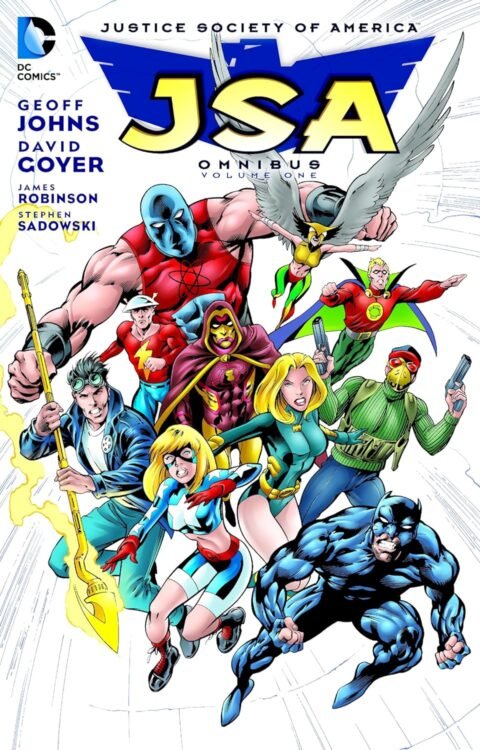
Those stories were also partly recollected in another hardcover collection:
- JSA by Geoff Johns Book One
Collects JLA/JSA Secret Files #1 and JSA #1-15. - JSA by Geoff Johns Book Two
Collects JSA #16-25, JSA: Our Worlds at War #1, JLA/JSA Secret Files & Origins #1 and JLA/JSA: Virtue and Vice. - JSA by Geoff Johns Book Three
Collects JSA: All Stars #1-8, JSA Annual #1, JSA Secret Files and Origins #2 and JSA #26-31, plus a never-before-collected story from JSA Secret Files #1 and a treasure trove of bonus material. - JSA by Geoff Johns Book Four
Collects JSA #32-45 - JSA by Geoff Johns Book Five
Collects JSA #46-58 and Hawkman #23-25.
JSA by Geoff Johns Paperback Editions
What follows is a list of the JSA trades, of course, but also of some of the JSA-related series written by Geoff Johns. We’ve got Stars and S.T.R.I.P.E. that follows the adventures of Courtney Whitmore, the new Star-Spangled Kid, and S.T.R.I.P.E., her stepfather with a robotic suit, as they battle aliens, cults, and villains; but Hawkman.
- Doctor Mid-Nite
Collects Doctor Mid-Nite #1–3 - Stargirl by Geoff Johns
Collects Stars and S.T.R.I.P.E. #1-14, JSA All-Stars #4, and stories from DCU Heroes Secret Files (1999) and DCU Villains Secret Files (1999). Avoid reading JSA All-Stars #4 here. For more information about Stargirl, go to our reading order dedicated to her.
- Justice Society Returns
Collects All Star Comics vol. 2 #1–2; Adventure Comics vol. 2 #1; All-American Comics vol. 2 #1; National Comics vol. 2 #1;Sensation Comics vol. 2 #1; Smash Comics vol. 2 #1; Star-Spangled Comics vol. 2 #1; Thrilling Comics vol. 2 #1; Golden Age Secret Files #1; JSA Secret Files #1. - JSA, vol. 1: Justice Be Done
Collects JSA #1–5; JSA Secret Files #1 - Day of Judgment
Collects Day of Judgment #1-5 and Day of Judgment Secret Files. - JSA, vol. 2: Darkness Falls
Collects JSA #6–15 - JSA, vol. 3: The Return of Hawkman
Collects JSA #16–25; JSA Secret Files #1 - JSA, vol. 4: Fair Play
Collects JSA #26–31; JSA Secret Files #2 - JSA, vol. 5: Stealing Thunder
Collects JSA #32–38 - Hawkman, vol. 1: Endless Flight
Collects Hawkman (2002) #1-6 and select profile entries from Hawkman Secret Files #1. - JLA/JSA: Virtue and Vice
- JSA, vol. 6: Savage Times
Collects JSA #39–45 - Hawkman, vol. 2: Allies & Enemies
Collects Hawkman #7-12. - JSA, vol. 7: Princes of Darkness
Collects JSA #46–55.

- JSA: All Stars
- Hawkman, vol. 3: Wings of Fury
Collects Hawkman #15-22. - JSA, vol. 8: Black Reign
Collects JSA #56–58; Hawkman vol. 4 #23–25. Also collected in Black Adam/JSA: Black Reign. - JSA, vol. 9: Lost
Collects JSA #59–67. Shazam left the JSA with #59. - Day of Vengeance
Collects Day of Vengeance #1-6, Action Comics #826, The Adventures of Superman #639, and Superman #216. - JSA, vol. 10: Black Vengeance
Collects JSA #68–75. JSA #73-75 are Day of Vengeance tie-in issues. - Hawkman, vol. 4: Rise of the Golden Eagle
Collects Hawkman #37-45. - The Rann-Thanagar War
Collects Rann-Thanagar War #1-6 and Rann-Thanagar War: Infinite Crisis Special #1 - Power Girl
Collects JSA #32, #39; JSA: Classified #1–4; Showcase #97–99; Secret Origins vol. 2 #11
![]() Big event with Infinite Crisis (see reading order). OMAC robots are rampaging, magic is dying, villains are uniting, and a war is raging in space. During this event, some of the surviving Golden Age characters are transported to the new “Earth-Two” created by Alexander Luthor Jr.
Big event with Infinite Crisis (see reading order). OMAC robots are rampaging, magic is dying, villains are uniting, and a war is raging in space. During this event, some of the surviving Golden Age characters are transported to the new “Earth-Two” created by Alexander Luthor Jr.
- Infinite Crisis
Collects Infinite Crisis #1–7. - JSA, vol. 11: Mixed Signals
Collects JSA #76–81. - JSA Classified: Honor Among Thieves
Collects JSA: Classified #5–9
One Year Later…
- Manhunter: Origins
Collects Manhunter #15-23. - JSA: Ghost Stories
Collects JSA #82–87.- Hawkgirl: Hawkman Returns
Collects Hawkgirl #57-60 and JSA: Classified #21-22.
- Hawkgirl: Hawkman Returns
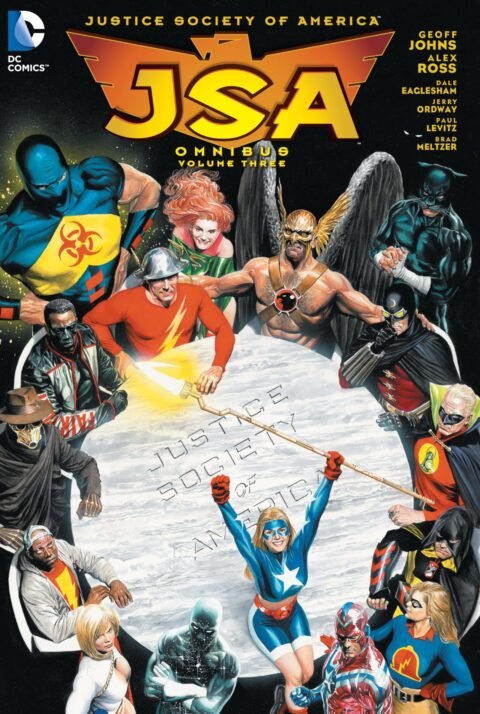
Jay Garrick, Alan Scott, and Ted Grant decided to revive the Justice Society. Volume 3 written by Geoff Johns with art by Dale Eaglesham starts here.
- Justice Society of America: The Next Age
Collects Justice Society of America vol. 3 #1–4. - JLA: The Lightning Saga
Collects Justice Society of America vol. 3 #5–6; Justice League of America vol. 2 #0, 8–12 - Justice Society of America: Thy Kingdom Come, vol. 1
Collects Justice Society of America vol. 3 #7–12 - Justice Society of America: Thy Kingdom Come, vol. 2
Collects Justice Society of America vol. 3 #13–18, Annual #1 - Justice Society of America: Thy Kingdom Come, vol. 3
Collects Justice Society of America vol. 3 #19–22; Justice Society Kingdom Come Special: Superman; the Justice Society Kingdom Come Special: Magog; Justice Society Kingdom Come Special: The Kingdom - Justice Society of America: Black Adam and Isis
Collects Justice Society of America vol. 3 #23–28. - Justice Society of America: The Bad Seed
Justice Society of America vol. 3 #29–33.
Geoff Johns’ run as writer of Justice Society of America ended with issue #26.
![]()
This is the Final Crisis (see reading order). Using the soul-destroying Anti-Life Equation, Darkseid is remaking the heroes, villains, and everyday people of Earth in his dark image … and destroying the very fabric of reality itself in the process. Now superheroes from around the world—and across the Multiverse—must make a last, desperate stand against the forces of Anti-Life.
- Final Crisis
collects DC Universe #0, Final Crisis #1-7, Final Crisis: Superman Beyond #1-2, Final Crisis: Submit #1, Batman #682-683 - Final Crisis: Legion of Three Worlds
collects Final Crisis: Legion of Three Worlds #1-5 - JSA vs Kobra
Collects JSA vs. Kobra #1–6. - Justice Society of America: Axis of Evil
Collects Justice Society of America vol. 3 #34–40- JSA Presents: Green Lantern
Collects Green Lantern: Brightest Day, Blackest Night (one-shot); JSA: Classified #25, #32–33 - JSA All-Stars: Constellations
Collects JSA All-Stars vol. 2 #1–6. Set during Blackest Night. - JSA All-Stars: Glory Days
Collects JSA All-Stars vol. 2 #7–13. - JSA All-Stars: The Puzzle Men collecting JSA All-Stars vol. 2 #14–18 was canceled.
- JSA Presents: Green Lantern
- Justice League of America: The Dark Things
Collects Justice Society of America vol. 3 #41–42; Justice League of America vol. 2 #44–48.- This crossover was written by James Robinson and ties into Brightest Day.
- Justice League of America: The Rise of Eclipso
Collects Justice Society of America vol. 3 #43; Justice League of America vol. 2 #54–60.
Marc Guggenheim became the new writer with issue #44, and Scott Kolins took over the art.
- Justice Society of America: Supertown
Collects Justice Society of America vol. 3 #44–49. - Justice Society of America: Monument Point
Collects Justice Society of America vol. 3 #50–54, Annual #2.
![]()
JSA on Earth-Two during NEW 52
The post-Crisis Earth-2 was introduced in a single panel in the final issue of the 52 weekly series. It’s not the same Earth-Two of the past. This was confirmed in Justice Society of America (vol. 3) Annual #1.
In September 2011, DC Comics relaunched its universe and a new Earth-2 was announced. The series just called Earth 2, first written by James Robinson and then by Tom Taylor, explored the formation of the Justice Society. This time, it’s not old heroes, but superheroes only just now appearing. After the main heroes of this Earth died, the Flash (Jay Garrick), Hawkgirl (Kendra Saunders), and Green Lantern (Alan Scott) team up and formed a new JSA.
The series is divided into three volumes: Earth 2 Vol 1 (2012–2015), Earth 2 World’s End (2014–2015), and Earth 2: Society (2015–2017). Check out our Earth 2 New 52 Reading order for an issue-by-issue reading list!
- Earth 2, vol. 1: The Gathering
Collects Earth 2 #1–6. - Earth 2, vol. 2: The Tower of Fate
Collects Earth 2 #0,7–10. - Earth 2, vol. 3: Battle Cry
Collects Earth 2 #13–16, Annual #1. - Earth 2, vol. 4: The Dark Age
Collects Earth 2 #17–20, Annual #2. - Earth 2, vol. 5: The Kryptonian
Collects Earth 2 #21–26, Earth 2: Futures End #1. - Earth 2, vol. 6: Collision
Collects Earth 2 #27-32. - Earth 2: World’s End Vol. 1
Collects Earth 2: World’s End #1–11. - Earth 2: World’s End Vol. 2
Collects Earth 2: World’s End #12–26. - Convergence: Infinite Earths Book One
Collects Convergence: Justice Society Of America #1-2, Convergence: Infinity Inc. #1-2, Convergence: Detective Comics #1-2, Convergence: World’s Finest Comics #1-2 And Convergence: Action Comics #1-2. Ties into Convergence. - Earth 2: Society, vol. 1: Planetfall
Collects Earth 2: Society #1-7. - Earth 2: Society, vol. 2: Indivisible
Collects Earth 2: Society #8-12. - Earth 2: Society, vol. 3: Whole New World
Collects Earth 2: Society #13-16, Earth 2: Society Annual #1. - Earth 2: Society, vol. 4: Life After Death
Collects Earth 2: Society #17-22.
![]()
JSA during DC Rebirth
DC Rebirth is the 2016 relaunch of the DC Universe. This time, the Justice Society of America is not back. At first. Geoff Johns used the JSA in his Watchmen sequel, Doomsday Clock. Then, the Justice Society returned in the pages of Justice League, made an appearance in the pages of the fifth volume of Hawkman, and we saw them fight in the pages of “Dark Nights: Death Metal“.
- Doomsday Clock
Collects Doomsday Clock #1-12. The real collision between Watchmen and the DC Universe. - Hawkman Vol. 4: Hawks Eternal
Collects Hawkman #20-29. - Dark Nights: Death Metal
Collects Dark Nights: Death Metal #1-7.
![]()
Justice Society of America: The New Golden Age
The JSA returns as well as writer Geoff Johns–working with artist Mikel Janín. “The New Golden Age” one-shot reintroduced the Justice Society of America and other Golden Age characters by exploring the past, present, and future of the DC multiverse.
This story led to a new era presented as part of the “Dawn of DC” initiative with a new Justice Society of America series, but also three new six-issue miniseries: Alan Scott: The Green Lantern by Tim Sheridan and Cian Tormey, Jay Garrick: The Flash by Jeremy Adams and Diego Olortegui, and Wesley Dodds: The Sandman by Robert Venditti and Riley Rossmo.
Prelude to the New Golden Age
- Stargirl Spring Break Special #1 (one-shot)
- Dark Crisis On Infinite Earths
Collects Justice League #75 and Dark Crisis on Infinite Earths #0-7. - Flashpoint Beyond
Collects Flashpoint Beyond #0 and #1-6. - Stargirl: The Lost Children
Collects Stargirl: The Lost Children #1-6.
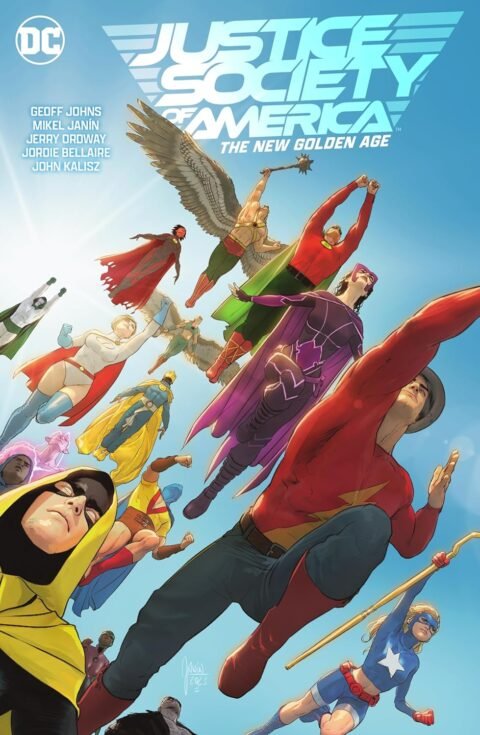
The New Golden Age
- Justice Society of America Vol. 1: The New Golden Age
Collects The New Golden Age #1 and Justice Society of America #1-7. - Alan Scott: The Green Lantern
Collects Alan Scott: The Green Lantern #1-6. - Jay Garrick: The Flash
Collects Jay Garrick: The Flash #1-6. - Wesley Dodds: The Sandman
Collects Wesley Dodds: The Sandman #1-6.
Did we forget an important issue? Did we make a mistake? Let us know in the comments!